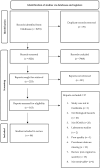Biological Hazards and Indicators Found in Products of Animal Origin in Cambodia from 2000 to 2022: A Systematic Review
- PMID: 39767462
- PMCID: PMC11675544
- DOI: 10.3390/ijerph21121621
Biological Hazards and Indicators Found in Products of Animal Origin in Cambodia from 2000 to 2022: A Systematic Review
Abstract
Biological hazards in products of animal origin pose a significant threat to human health. In Cambodia, there are few comprehensive data and information on the causes of foodborne diseases or risks. To date, there has been no known published study similar to this review. This systematic review is aimed to investigate the prevalence of biological hazards and their indicators in products of animal origin from 2000 to 2022. The main objective of this study was also to contribute to strengthening Cambodia's food control system. This review followed the established "Preferred Reporting Items for Systematic Reviews and Meta-Analyses" (PRISMA) guidelines. In total, 46 studies were retained for complete review. Most studies (n = 40) had been conducted by or with external researchers, reflecting the under-resourcing of the National Food Control System in terms of surveillance; areas outside the capital were relatively understudied, reflecting evidence found in Ethiopia and Burkina Faso. Five categories of hazards were reported with the highest number of studies on fish parasites. Marketed fish, often originating from different countries, had a higher mean value of parasite prevalence (58.85%) than wild-caught fish (16.46%). Viral pathogens in bat meat presented a potential spillover risk. Many potentially important hazards had not yet been studied or reported (e.g., Norovirus, Shigella, toxin-producing Escherichia coli, and Vibrio cholerae). The findings of our review highlighted significant urgencies for national competent authorities to enhance food hygiene practices along the production chain, tackle import control, and enforce the implementation of a traceability system, alongside more research collaboration with neighboring countries and key trading partners. It is crucial to conduct more extensive research on food safety risk analysis, focusing on the identification and understanding of various biological hazards and their associated risk factors in food.
Keywords: Cambodia; biological hazards and hazard indicators; food control system; products of animal origin; systematic review.
Conflict of interest statement
The authors declare no conflicts of interest.
Figures







Similar articles
-
Systemic pharmacological treatments for chronic plaque psoriasis: a network meta-analysis.Cochrane Database Syst Rev. 2021 Apr 19;4(4):CD011535. doi: 10.1002/14651858.CD011535.pub4. Cochrane Database Syst Rev. 2021. Update in: Cochrane Database Syst Rev. 2022 May 23;5:CD011535. doi: 10.1002/14651858.CD011535.pub5. PMID: 33871055 Free PMC article. Updated.
-
[Volume and health outcomes: evidence from systematic reviews and from evaluation of Italian hospital data].Epidemiol Prev. 2013 Mar-Jun;37(2-3 Suppl 2):1-100. Epidemiol Prev. 2013. PMID: 23851286 Italian.
-
Home treatment for mental health problems: a systematic review.Health Technol Assess. 2001;5(15):1-139. doi: 10.3310/hta5150. Health Technol Assess. 2001. PMID: 11532236
-
Systemic pharmacological treatments for chronic plaque psoriasis: a network meta-analysis.Cochrane Database Syst Rev. 2017 Dec 22;12(12):CD011535. doi: 10.1002/14651858.CD011535.pub2. Cochrane Database Syst Rev. 2017. Update in: Cochrane Database Syst Rev. 2020 Jan 9;1:CD011535. doi: 10.1002/14651858.CD011535.pub3. PMID: 29271481 Free PMC article. Updated.
-
Chemical Hazards in Products of Animal Origin in Cambodia from 2000 to 2023: A Systematic Review and Meta-Analysis.Int J Environ Res Public Health. 2025 Aug 19;22(8):1299. doi: 10.3390/ijerph22081299. Int J Environ Res Public Health. 2025. PMID: 40869884 Review.
References
-
- World Health Organization Foodborne Diseases. [(accessed on 12 August 2024)]. Available online: https://www.who.int/health-topics/foodborne-diseases#tab=tab_1.
-
- World Health Organization Food Safety Website. [(accessed on 17 October 2024)]. Available online: https://www.who.int/news-room/fact-sheets/detail/food-safety#:~:text=Maj....
-
- Grace D. Burden of Foodborne Disease in Low-Income and Middle-Income Countries and Opportunities for Scaling Food Safety Interventions. Food Secur. 2023;15:1475–1488. doi: 10.1007/s12571-023-01391-3. - DOI
-
- Jaffee S., Henson S., Unnevehr L., Grace D., Cassou E. The Safe Food Imperative: Accelerating Progress in Low- and Middle-Income Countries. World Bank; Washington, DC, USA: 2019. - DOI
-
- Grace D. Food Safety in Developing Countries: An Overview. UK Department for International Development; London, UK: 2015. - DOI
Publication types
MeSH terms
LinkOut - more resources
Full Text Sources
Medical

